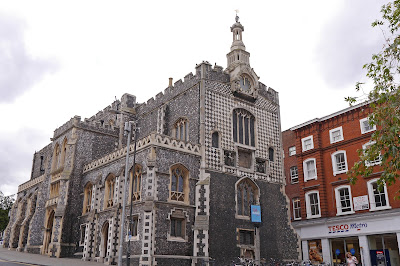The Royal Arcade
We have just arrived in Norwich at the start of a short visit to Norfolk with our friends Merv and Pud. This post describes an excellent initial stroll around the city centre. The highlight was the incredible Royal Arcade, of which more later.
We started our walk, guided by Pud who was brought up in Norwich, in Elm Hill, a very picturesque street, and chuckled as we passed a jeweller's called Stoned and Hammered.
At the top is a wonderful old house, now a coffee bar and restaurant, called Britons Arms.
We passed The Halls, once the site of a monastery ...
... and in Bridewell Alley saw the former Bridewell. A plaque outside explains that it was built in the 14th century and was acclaimed as the finest piece of flint work in England. Closer inspection reveals that it was built with flints shaped into square bricks - how hard must that have been to do? It was originally a rich merchant's house, but became a prison for women and beggars (a ‘Bridewell’) in 1585 and in the mid 18th century became a conventional prison. Later it was a factory and warehouse, eventually becoming a museum.
From here Swan Lane and London St led us to Gaol Hill and the handsome Guildhall. It was built between 1407 and 1413 and served as the seat of the city's government, including being the city gaol, from then until 1938, when it was replaced by the new City Hall.
On the left was the market occupying a site where it has been since medieval times. We turned left into St Peter's Street to pass in front of the City Hall.
It is a fairly plain building, but the tower is imposing - a little like the contemporary example in Southampton - and the stylised lions outside the main door are pleasing. I was surprised by Pevsner's assessment however: "the foremost English public building of between the wars". Standing with your back to the City Hall, you can see the Castle perched on its hill.
Next up was St John Manthorp, an imposing 14th century church.
Inside all is light and the magnificent roof with its wooden fan vaulting and carved angels was a wonderful sight. We saw similar angels in Stamford recently.
Inside the main rooms were exquisitely painted and plastered.
Now we walked back down Theatre St and turned right beside St John Manthorp to reach Haymarket and Gentleman's Walk, where on the right we entered The Royal Arcade of 1899 by the architect George Skipper.
Inside there was a harmonious composition of pale green and cream bricks with bands and panels of ceramic flowers.
There was also beautiful stained glass over the rear exit.
On the way back we passed this fine house in Princes St, Garsett House. It seems to have originally been medieval, hence the jettied out up storeys, but was then remodelled in Georgian times.
Finally, going through the area known as Tombland, we walked through the courtyard of Augustine Steward House built in 1549. We marvelled at the absence of straight lines.
My final picture shows Samson and Hercules House (after the figures in the porch who were put there in 1890) and which now houses an American-style lobster bar. It was apparently a dance hall in the 1930s and is said to date from 1657.
We were staying in the nearby Maids Head hotel, so this marked the of a wonderful introduction to the city. Tomorrow we will visit the Cathedral.
Conditions: warm with some cloud and some sunshine.
Distance: maybe 3 miles.
Rating: five stars. The Royal Arcade is an absolute gem.

















No comments:
Post a Comment